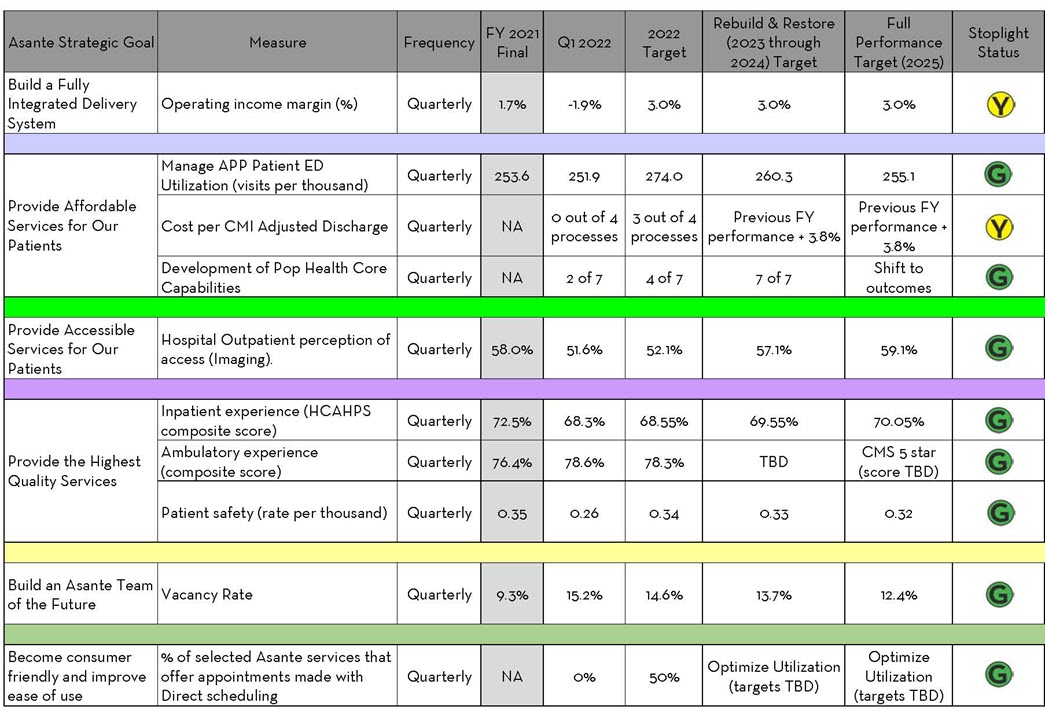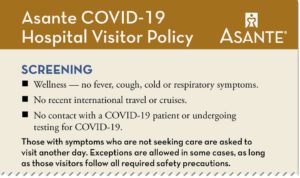Share:
Like health care organizations throughout the country, Asante’s operations and financial performance have been pummeled by the pandemic. At a recent Asante Leadership Forum, CEO Scott Kelly shared the FY 2021-2022 Balanced Scorecard, the guide used for everything from measuring how Asante will meet its strategic goals to employee incentives.
“It’s been a tough first quarter,” Kelly said. “It’s going to take us some time to get back to where we were.”
Because of this, the current Balanced Scorecard sets goals not just for the current fiscal year, but also for 2023 and 2024 to allow time to “restore and rebuild” from the effects of pandemic.

For the first time in several years, Asante did not meet its goal of a 3% operating margin in the first quarter of this fiscal year (October through December 2021). The operating margin came in at -1.9% for Q1, the result of an unprecedented need for contract labor, including nurse travelers, and declining revenues caused by canceled procedures and longer inpatient stays. The measure remains in the “yellow,” however, because there is still a chance to meet the target by year’s end in September.
“There’s no need for panic because we’ve been here before,” Kelly said, reminding leaders that 2008 and 2017 brought financial difficulties from which Asante rebounded.
To help Asante recover from this dip, the organization will focus more tightly on key priorities in the coming year. Instead of 11 or 12 measures, the current scorecard has been narrowed to 10 based on the system’s Strategic Plan. Key among them is to provide affordable services for patients. This means helping APP’s highest-risk patients stay out of the hospital by ensuring they have ready access to their providers and to care managers, who can help identify medical or environmental risks before they become acute. Based on first-quarter results, Asante so far is meeting its targets on those measures.
Asante continues to focus on patient experience in both hospitals and outpatient facilities. Recent results show performance is on track to meet goals for the year despite a 4.5% decline in patient experience scores nationwide.
Patient safety remains a key scorecard measure because it lies at the core of Asante’s purpose. Safety rates are based on the number of health-care-acquired infections per patient population. Performance in this area is down from last year but a dramatic increase in patient volumes buoyed that measure into the green for the first quarter of FY2022. The infections tracked are catheter-associated urinary tract infections (CAUTI), central-line-associated bloodstream infections (CLABSI) and surgical site infections as well as transmissible infections such as C. difficile and MRSA.
New on this year’s scorecard is Asante’s job vacancy rate. The system ended Q1 with a vacancy rate of 15.2% compared with 9.3% at the end of the last fiscal year. Although the vaccination mandate had some effect on the vacancy rate, it was minor compared with the employment exodus happening here and all over the country. Kelly cited one national study that found that two-thirds of acute and critical care nurses were considering leaving their jobs, and nearly a third of all health care workers are thinking of other professions.
To bring vacancy numbers back into the single digits, Asante has embarked on an ambitious employee retention initiative as well as bolstering its recruiting efforts and improving employee engagement. “The good news is that we’re hiring at a clip we’ve never seen,” Kelly said.
Other new measures include the percentage of Asante services that offer direct scheduling through MyChart and patients’ perception of access to outpatient imaging.
“This is definitely a three-year Balanced Scorecard,” Kelly said. “But we are looking to make some improvements in 2022.”
If you have a question, please contact the author or relevant department directly.



